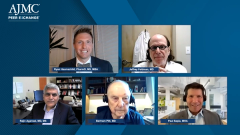
Using Published Data to Consider SGLT2 Inhibitors and MRAs in CKD Management
Dr Jeffrey Feldman discusses finerenone trial data and the role that it and SGLT2 inhibitors have played in patients with CKD.
Episodes in this series

Ryan Haumschild, PharmD, MS, MBA: Dr Feldman, hearing these positive results, how do you use finerenone at your practice? Are you starting to consider it for unique patients? Are you starting to use it in combination with SGLT2 inhibitors based on some of the data that we’ve seen thus far?
Jeffrey Feldman, MD: What Dr Agarwal alluded to is that the IDNT and RENAAL trials were in 2000 and 2001, and there are multiple other drugs that were tried between 2001 and 2015 or 2016 when SGLT2 inhibitors came on, and then last year when finerenone came on. [Before SGLT2 inhibitors and finerenone,] they all were dreadfully unsuccessful, and we had nothing in our toolbox to slow the process.
One thing is that when a patient comes to me, they think the first thing I’m going to do is say, “You’re ready for dialysis.” Basically, I use the guideline-directed therapy to slow the loss of renal function—what Dr Agarwal said—the decrease in serum creatinine by doubling, the [reduction] of eGFR [estimated glomerular filtration rate] by 57%. You now look at the eGFR over time.
One of Dr Agarwal’s colleagues…says graceful aging is when after the age of 35—I like to think it’s 40, but he says 35—you lose about 0.8 to 1 mL/min of eGFR per year. If you’re hypertensive, that can go up to 6 or 8 mL/min. RENAAL and IDNT slowed it a little. SGLT2 inhibitors drop it down to about 2.8 mL/min. On top of what Dr Agarwal said, with ACE [angiotensin-converting enzyme] inhibitors, ARBs [angiotensin receptor blockers], SGLT2 inhibitors, and adding MRAs [mineralocorticoid receptor antagonists], you can probably drop it down to 1.5 mL/min. That means that if somebody comes to me with an eGFR of 45 mL/min and I use combination therapy, normal loss of renal function in a diabetic with hypertension would be 4 or 5 mL/min a year. They would have been looking at dialysis in about 5 or 6 years. In addition, as their eGFR drops, they’re at risk for heart failure and coronary events and strokes.
By using these medicines and slowing the loss of renal function, the loss of eGFR, on a yearly basis, you can assure people that they will have fewer cardiovascular events and less heart failure, and probably prevent the need for dialysis if they live that long.
People used to get a transplant. When I started transplants, it would last for 8 or 10 years. We called that dialysis vacation. Now we have medications to do the same thing that transplants do, and they should be used in combination, because the combination on top of ACEs and ARBs with SGLT2 inhibitors and MRAs, you can reduce the loss of eGFR filtration, decrease the albumin-to-creatinine ratio, and bring it into a more normal range, hopefully someday down to about 1.5 or even 1 mL/min with newer stuff coming onto the market, ie, GLP-1 RAs [receptor agonists], which are most likely also renoprotective.
Ryan Haumschild, PharmD, MS, MBA: [I have] a brief question for you. Have your patients provided any feedback as you’ve started to use finerenone on its ease of use or tolerability compared with previous treatments?
Jeffrey Feldman, MD: As Dr Agarwal alluded to, unfortunately, these are still MRAs, and hyperkalemia is a real issue. I’ll close out the session with the economic value; we do have treatment for hyperkalemia so you don’t have to stop these medicines. You can continue the medicines and use the alluded-to potassium binders, a low potassium diet, and keep the patients on their medicines, and they feel better. Patients tell me they feel better, particularly if they’ve had heart failure and symptoms of fatigue and weakness. The patients notice a difference, and it’s [usually] with combination-type therapy.
Transcript edited for clarity.
Newsletter
Stay ahead of policy, cost, and value—subscribe to AJMC for expert insights at the intersection of clinical care and health economics.







































